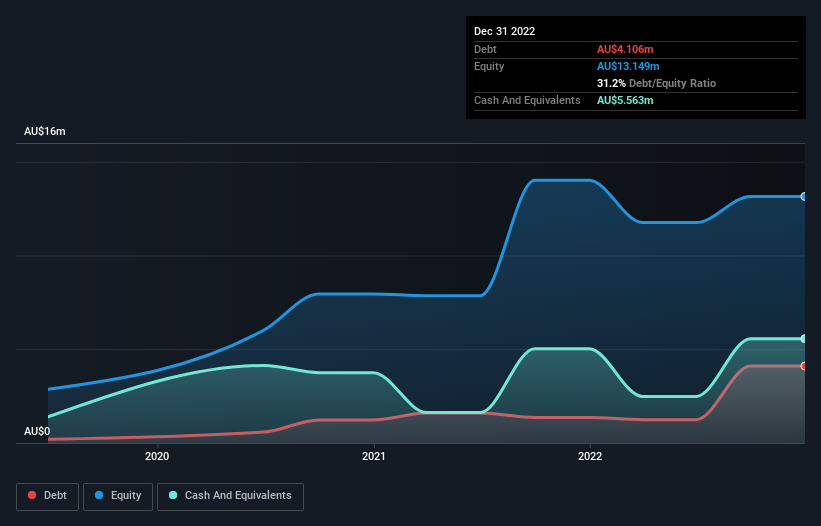Legendary fund manager Li Lu (who Charlie Munger backed) once said, 'The biggest investment risk is not the volatility of prices, but whether you will suffer a permanent loss of capital.' So it might be obvious that you need to consider debt, when you think about how risky any given stock is, because too much debt can sink a company. As with many other companies Pure Foods Tasmania Limited (ASX:PFT) makes use of debt. But the real question is whether this debt is making the company risky.
What Risk Does Debt Bring?
Debt is a tool to help businesses grow, but if a business is incapable of paying off its lenders, then it exists at their mercy. If things get really bad, the lenders can take control of the business. However, a more usual (but still expensive) situation is where a company must dilute shareholders at a cheap share price simply to get debt under control. Of course, debt can be an important tool in businesses, particularly capital heavy businesses. When we think about a company's use of debt, we first look at cash and debt together.
See our latest analysis for Pure Foods Tasmania
What Is Pure Foods Tasmania's Debt?
As you can see below, at the end of December 2022, Pure Foods Tasmania had AU$4.11m of debt, up from AU$1.36m a year ago. Click the image for more detail. However, it does have AU$5.56m in cash offsetting this, leading to net cash of AU$1.46m.

How Healthy Is Pure Foods Tasmania's Balance Sheet?
Zooming in on the latest balance sheet data, we can see that Pure Foods Tasmania had liabilities of AU$4.44m due within 12 months and liabilities of AU$3.26m due beyond that. Offsetting this, it had AU$5.56m in cash and AU$1.05m in receivables that were due within 12 months. So its liabilities total AU$1.08m more than the combination of its cash and short-term receivables.
Given Pure Foods Tasmania has a market capitalization of AU$14.3m, it's hard to believe these liabilities pose much threat. However, we do think it is worth keeping an eye on its balance sheet strength, as it may change over time. Despite its noteworthy liabilities, Pure Foods Tasmania boasts net cash, so it's fair to say it does not have a heavy debt load! There's no doubt that we learn most about debt from the balance sheet. But it is Pure Foods Tasmania's earnings that will influence how the balance sheet holds up in the future. So if you're keen to discover more about its earnings, it might be worth checking out this graph of its long term earnings trend.
Over 12 months, Pure Foods Tasmania made a loss at the EBIT level, and saw its revenue drop to AU$8.7m, which is a fall of 7.7%. We would much prefer see growth.
So How Risky Is Pure Foods Tasmania?
We have no doubt that loss making companies are, in general, riskier than profitable ones. And the fact is that over the last twelve months Pure Foods Tasmania lost money at the earnings before interest and tax (EBIT) line. And over the same period it saw negative free cash outflow of AU$4.1m and booked a AU$3.1m accounting loss. Given it only has net cash of AU$1.46m, the company may need to raise more capital if it doesn't reach break-even soon. Overall, we'd say the stock is a bit risky, and we're usually very cautious until we see positive free cash flow. There's no doubt that we learn most about debt from the balance sheet. But ultimately, every company can contain risks that exist outside of the balance sheet. These risks can be hard to spot. Every company has them, and we've spotted 4 warning signs for Pure Foods Tasmania (of which 3 make us uncomfortable!) you should know about.
If you're interested in investing in businesses that can grow profits without the burden of debt, then check out this free list of growing businesses that have net cash on the balance sheet.
New: Manage All Your Stock Portfolios in One Place
We've created the ultimate portfolio companion for stock investors, and it's free.
• Connect an unlimited number of Portfolios and see your total in one currency
• Be alerted to new Warning Signs or Risks via email or mobile
• Track the Fair Value of your stocks
Have feedback on this article? Concerned about the content? Get in touch with us directly. Alternatively, email editorial-team (at) simplywallst.com.
This article by Simply Wall St is general in nature. We provide commentary based on historical data and analyst forecasts only using an unbiased methodology and our articles are not intended to be financial advice. It does not constitute a recommendation to buy or sell any stock, and does not take account of your objectives, or your financial situation. We aim to bring you long-term focused analysis driven by fundamental data. Note that our analysis may not factor in the latest price-sensitive company announcements or qualitative material. Simply Wall St has no position in any stocks mentioned.
About ASX:PFT
Moderate risk with mediocre balance sheet.
Market Insights
Community Narratives




